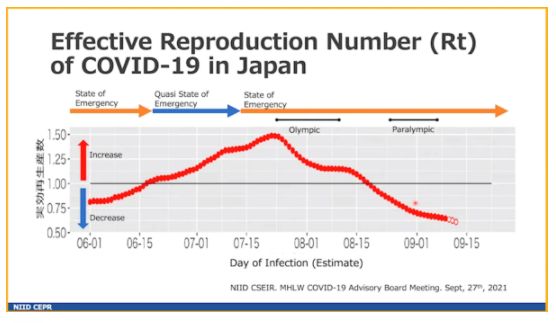New Data Shows No COVID-19 Spread Between Tokyo 2020 Participants And Local Population
30 December 2021. Genomic sequencing data from the Government of Japan has confirmed there was no spread of the new coronavirus between participants of the postponed Olympic and Paralympic Games Tokyo 2020 this year and the local population.
The findings confirm that the positive cases in the Olympic Village and those of the residents of Japan were unrelated. This once again demonstrates the success of the countermeasures put in place for the Games.

The data was released by Dr Saito Tomoya, Director of the Centre of Emergency Preparedness and Response of Japan’s National Institute of Infectious Diseases (NIID), during the International Olympic Committee (IOC) World Conference on Prevention of Injury & Illness in Sport, at the end of last month in Monaco.
He was followed by Dr Brian McCloskey, Chair of the Independent Expert Panel on COVID-19 countermeasures for Tokyo 2020, who presented the results of the efforts by the organisers to ensure safe Games and the lessons for future events in a pandemic.
According to Dr Saito, the dominant SARS-CoV-2 variant in Japan, AY.29, probably originated from the initial Delta strain that first entered the country around May, two months before the Games. This variant is not endemic anywhere else in the world. “That means there is no evidence that the virus was spread to the rest of the world by participants in Tokyo 2020. And no epidemic other than AY.29 in Japan means that virus strains that were brought in by the participants did not spread in Japan,” he said.
This is backed by the breakdown of COVID-19 cases between athletes and officials, and the other accredited participants of the Games. As the other participants were largely Japanese residents living in or around Tokyo, the number of cases among them went up at the same time as local cases were increasing. On the other hand, imported cases from athletes and officials, the majority of whom were overseas visitors staying at the Olympic Village or Games accommodation, were contained effectively.
Furthermore, the reproduction rate of COVID-19 in Japan, which had been surging since early June, started to decrease around the beginning of the Olympic Games on 23 July. “So overall, there seems to be no negative, direct impact to the epidemic in Tokyo during the Games,” concluded Dr Saito.
In the following presentation, Dr McCloskey explained how a combination of standard public health and social measures (physical distancing, respiratory and hand hygiene, mask wearing, ventilation) with a comprehensive test, track and trace programme and a global vaccination effort by the Olympic Movement helped keep the pandemic at bay during the Games.
Dr McCloskey said: “These results support the approach, advocated by the World Health Organization, that tackling and managing the COVID-19 pandemic depends on using all the options available – public health and social measures, robust test and trace systems, and vaccination. Relying on any one of these alone is unlikely to be effective. The results also show that, despite the criticisms and concerns expressed before the Games, Tokyo 2020 did not lead to a spreading event, let alone a super spreading event, and mass events can be delivered safely if the appropriate countermeasures are in place.”
With only 33 positive cases among the 11,300 athletes and 464 overall among tens of thousands of accredited stakeholders, the Olympic Games proved to be safe for both participants and the population of Japan.
The learnings from all Tokyo 2020 countermeasures have also informed the planning for the Olympic Winter Games Beijing 2022, which will operate under a closed-loop management system to keep Games participants and people in China safe through reducing unnecessary interactions. The COVID-19 guidelines for the upcoming Winter Games have been outlined in the Beijing 2022 Playbooks.


 Big Shift Global Campaign: The World Bank Is Making Bad Economic Decisions | U-Turning On Its Energy Policies
Big Shift Global Campaign: The World Bank Is Making Bad Economic Decisions | U-Turning On Its Energy Policies UN Department of Global Communications: FAO Releases The Most Detailed Global Assessment Of Marine Fish Stocks To Date
UN Department of Global Communications: FAO Releases The Most Detailed Global Assessment Of Marine Fish Stocks To Date World Economic Forum: Gender Gap Closes At Fastest Rate Since Pandemic
World Economic Forum: Gender Gap Closes At Fastest Rate Since Pandemic KidsRights: KidsRights Index 2025 Now Available
KidsRights: KidsRights Index 2025 Now Available CNS: We Can Do Better So That All People With HIV Live Healthy Normal Lifespans
CNS: We Can Do Better So That All People With HIV Live Healthy Normal Lifespans John Divinagracia, IMI: The Evolution Of Mankind’s First Voice - How Drums Shape The Human Story
John Divinagracia, IMI: The Evolution Of Mankind’s First Voice - How Drums Shape The Human Story